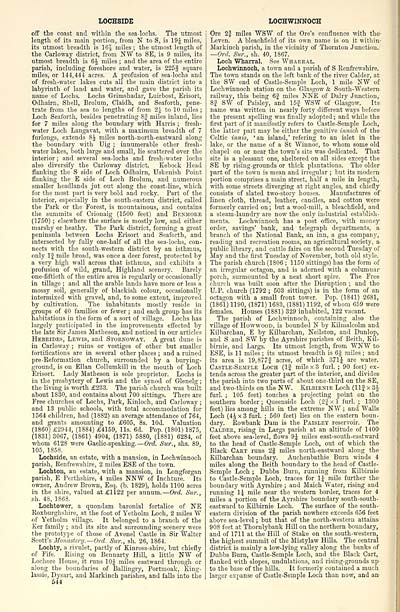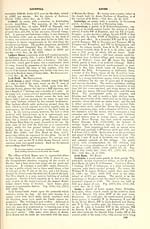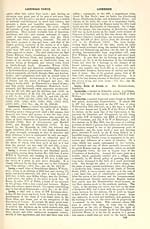Ordnance gazetteer of Scotland > Volume 5
(64) Page 544
Download files
Complete book:
Individual page:
Thumbnail gallery: Grid view | List view

LOCHSIDE
LOCHWINNOCH
off the coast and within the sea-lochs. The utmost
length of its main portion, from N to S, is 19J miles,
its utmost breadth is 16|- miles ; the utmost length of
the Carloway district, from NW to SE, is 9 miles, its
utmost breadth is 6J miles ; and the area of the entire
parish, including foreshore and water, is 225§ square
miles, or 144,444 acres. A profusion of sea-lochs and
of fresh-water lakes cuts all the main district into a
labyrinth of land and water, and gave the parish its
name of Lochs. Lochs Grimshadar, Luirbost, Erisort,
Odhairn, Shell, Brolum, Claidh, and Seaforth, pene-
trate from the sea to lengths of from 2\ to 10 miles ;
Loch Seaforth, besides penetrating 8f miles inland, lies
for 7 miles along the boundary with Harris ; fresh-
water Loch Langavat, with a maximum breadth of 7
furlongs, extends 8J miles north-north-eastward along
the boundary with Uig ; innumerable other fresh-
water lakes, both large aud small, lie scattered over the
interior ; and several sea-lochs and fresh -water lochs
also diversify the Carloway district. Kebock Head
flanking the S side of Loch Odhairn, ITskeuish Point
flanking the E side of Loch Brolum, and numerous
smaller headlands jut out along the coast-line, which
for the most part is very bold and rocky. Part of the
interior, especially in the south-eastern district, called
the Park or the Forest, is mountainous, and contains
the summits of Crionaig (1500 feet) and Benmoee
(1750) ; elsewhere the surface is mostly low, and either
marshy or heathy. The Park district, forming a great
peninsula between Lochs Erisort and Seaforth, and
intersected by fully one-half of all the sea-lochs, con-
nects with the south-western district by an isthmus,
only If mile broad, was once a deer forest, protected by
a very high wall across that isthmus, and exhibits a
profusion of wild, grand, Highland scenery. Barely
one-fiftieth of the entire area is regularly or occasionally
in tillage ; and all the arable lands have more or less a
mossy soil, generally of blackish colour, occasionally
intermixed with gravel, and, to some extent, improved
by cultivation. The inhabitants mostly reside in
groups of 40 families or fewer ; and each group has its
habitations in the form of a sort of village. Lochs has
largely participated in the improvements effected by
the late Sir James Matheson, and noticed in our articles
Hebrides, Lewis, and Stornowat. A great dune is
in Carlowaj' ; ruins or vestiges of other but smaller
fortifications are in several other places ; and a ruined
pre-Reformation church, surrounded by a burying-
ground, is on Elian Collumkill in the mouth of Loch
Erisort. Lady Matheson is sole proprietor. Lochs is
in the presbytery of Lewis and the synod of Glenelg ;
the living is worth £233. The parish church was built
about 1830, and contains about 700 sittings. There are
Free churches of Lochs, Park, Kinloch, and Carloway ;
and 13 public schools, with total accommodation for
1564 children, had (1882) an average attendance of 764,
and grants amounting to £605, 8s. lOd. Valuation
(1860) £2944, (1884) £4159, lis. 6d. Pop. (1801) 1875,
(1831) 3067, (1861) 4904, (1871) 5880, (1881) 6284, of
whom 6128 were Gaelic-speaking. — Ord. Sur., shs. 89,
105, 1858.
Lochside, an estate, with a mansion, in Lochwinnoch
parish, Renfrewshire, 2 miles ESE of the town.
IiOchton, an estate, with a mansion, in Longforgan
parish, E Perthshire, 4 miles NNW of Inchture. Its
owner, Andrew Brown, Esq. (b. 1829), holds 1100 acres
in the shire, valued at £1122 per annum. — Ord. Sur.,
fih. 48, 1868.
Lochtower, a quondam baronial fortalice of NE
Roxburghshire, at the foot of Yetholm Loch, 2 miles W
of Yetholm village. It belonged to a branch of the
Ker familj' ; and its site and surrounding scenery were
the prototype of those of Avenel Castle in Sir Walter
Scott's Monastery. — Ord. Sur., sh. 26, 1864.
Lochty, a rivulet, partly of Kinross-shire, but chiefly
of Fife. Rising on Bennarty Hill, a little NW of
Lochore House, it runs lOJ miles eastward through or
along the boundaries of Ballingry, Portmoak, King-
lassie, Dysart, and Markinch parishes, and falls into the
544
Ore 2| miles WSW of the Ore's confluence with the-
Leven. A bleachfield of its own name is on it within-
Markinch parish, in the vicinity of Thornton Junction.
—Ord. Sur., sh. 40, 1867.
Loch Wharral. See Whaeral.
Loohwinnooh, a town and a parish of S Renfrewshire.
The town stands on the left bank of the river Calder, at
the SW end of Castle-Semple Loch, 1 mile NW of
Lochwinnoch station on the Glasgow & South-Western
railway, this being 6| miles NNE of Dairy Junction,
8S SW of Paisley, and 15-2 WSW of Glasgow. Its
name was written in nearly forty different ways before
the present spelling was finally adopted; and while the
first part of it manifestly refers to Castle-Semple Loch,
the latter part may be either the genitive innich of the
Celtic innis, 'an island,' refering to an islet in tho
lake, or the name of a St Winnoc, to whom some old
chapel on or near the town's site was dedicated. That
site is a pleasant one, sheltered on all sides except the
SE by rising-grounds or thick plantations. The older
part of the town is mean and irregular ; but its modern
portion comprises a main street, half a mile in length,
with some streets diverging at right angles, and chiefly
consists of slated two-story houses. Manufactures ot
linen cloth, thread, leather, candles, and cotton were
formerly carried on ; but a wool-mill, a bleachfield, and
a steam-laundrj' are now the only industrial establish-
ments. Lochwinnoch has a post office, with money
order, savings' bank, and telegraph departments, a
branch of the National Bank, an inn, a gas company,
reading and recreation rooms, an agricultural society, Sr
public library, and cattle fairs on the second Tuesday of
May and the first Tuesday of November, both old style.
The parish church (1806 ; 1150 sittings) has the form of
an irregular octagon, and is adorned with a columnar
porch, surmounted by a neat short spire. The Free
church was built soon after the Disruption ; and the
U.P. church (1792 ; 503 sittings) is in the form of an
octagon with a small front tower. Pop. (1841) 2681,
(1861) 1190, (1871) 1683, (1881) 1192, of whom 659 were
females. Houses (1881) 329 inhabited, 122 vacant.
The parish of Lochwinnoch, containing also the-
village of HowwooD, is bounded N by Kilmalcolm and
Kilbarchan, E by Kilbarchan, Neilston, and Dunlop,
and S and SW by the Ayrshire parishes of Beith, Kil-
birnie, and Largs. Its utmost length, from WNW to-
ESE, is 11 miles ; its utmost breadth is 6g miles ; and
its area is 19, 877 J acres, of which 371 J are water.
Castle-Semple Looh (If mile x 3 furl. ; 90 feet) ex-
tends across the greater part of the interior, and divides
the parish into two parts of about one-third on the SE,
and two-thirds on the NW. Kilbirnie Loch (11| x 3^
furl. ; 105 feet) touches a projecting point on the
southern border ; Queenside Loch (2J x 1 furl. ; 130O
feet) lies among hills in the extreme NW ; and Walls
Loch (4J X 3 furl. ; 560 feet) lies on the eastern boun-
dary. Rowbank Dam is the Paisley reservoir. The
Calder, rising in Largs parish at an altitude of 1400-
feet above sea-level, flows 9^ miles east-south-eastward
to the head of Castle-Semple Loch, out of which the
Black Cart runs 2§ miles north-eastward along the
Kilbarchan boundary. Auchenbathie Burn winds 4
miles along the Beith boundary to the head of Castle-
Semple Loch ; Dubbs Buru, running from Kilbirnie
to Castle-Semple Loch, traces for IJ mUe further the
boundary with Ayrshire ; and Maich Water, rising and
running \\ mile near the western border, traces for 4
miles a portion of the Ayrshire boundary south-south-
eastward to Kilbirnie Loch. The surface of the south-
eastern division of the parish nowhere exceeds 656 feet
above sea-level ; but that of the north-western attains
908 feet at Thornlybank Hill on the northern boundary,
and of 1711 at the Hill of Stake on the south-western,
the highest summit of the Mistylaw HiUs. The central
district is mainly a low-lying valley along the banks of
Dubbs Burn, Castle-Semple Loch, and the Black Cart,
flanked with slopes, undulations, and rising-grounds up-
to the base of the hills. It formerly contained a much
larger expanse of Castle-Semple Loch than now, and an
LOCHWINNOCH
off the coast and within the sea-lochs. The utmost
length of its main portion, from N to S, is 19J miles,
its utmost breadth is 16|- miles ; the utmost length of
the Carloway district, from NW to SE, is 9 miles, its
utmost breadth is 6J miles ; and the area of the entire
parish, including foreshore and water, is 225§ square
miles, or 144,444 acres. A profusion of sea-lochs and
of fresh-water lakes cuts all the main district into a
labyrinth of land and water, and gave the parish its
name of Lochs. Lochs Grimshadar, Luirbost, Erisort,
Odhairn, Shell, Brolum, Claidh, and Seaforth, pene-
trate from the sea to lengths of from 2\ to 10 miles ;
Loch Seaforth, besides penetrating 8f miles inland, lies
for 7 miles along the boundary with Harris ; fresh-
water Loch Langavat, with a maximum breadth of 7
furlongs, extends 8J miles north-north-eastward along
the boundary with Uig ; innumerable other fresh-
water lakes, both large aud small, lie scattered over the
interior ; and several sea-lochs and fresh -water lochs
also diversify the Carloway district. Kebock Head
flanking the S side of Loch Odhairn, ITskeuish Point
flanking the E side of Loch Brolum, and numerous
smaller headlands jut out along the coast-line, which
for the most part is very bold and rocky. Part of the
interior, especially in the south-eastern district, called
the Park or the Forest, is mountainous, and contains
the summits of Crionaig (1500 feet) and Benmoee
(1750) ; elsewhere the surface is mostly low, and either
marshy or heathy. The Park district, forming a great
peninsula between Lochs Erisort and Seaforth, and
intersected by fully one-half of all the sea-lochs, con-
nects with the south-western district by an isthmus,
only If mile broad, was once a deer forest, protected by
a very high wall across that isthmus, and exhibits a
profusion of wild, grand, Highland scenery. Barely
one-fiftieth of the entire area is regularly or occasionally
in tillage ; and all the arable lands have more or less a
mossy soil, generally of blackish colour, occasionally
intermixed with gravel, and, to some extent, improved
by cultivation. The inhabitants mostly reside in
groups of 40 families or fewer ; and each group has its
habitations in the form of a sort of village. Lochs has
largely participated in the improvements effected by
the late Sir James Matheson, and noticed in our articles
Hebrides, Lewis, and Stornowat. A great dune is
in Carlowaj' ; ruins or vestiges of other but smaller
fortifications are in several other places ; and a ruined
pre-Reformation church, surrounded by a burying-
ground, is on Elian Collumkill in the mouth of Loch
Erisort. Lady Matheson is sole proprietor. Lochs is
in the presbytery of Lewis and the synod of Glenelg ;
the living is worth £233. The parish church was built
about 1830, and contains about 700 sittings. There are
Free churches of Lochs, Park, Kinloch, and Carloway ;
and 13 public schools, with total accommodation for
1564 children, had (1882) an average attendance of 764,
and grants amounting to £605, 8s. lOd. Valuation
(1860) £2944, (1884) £4159, lis. 6d. Pop. (1801) 1875,
(1831) 3067, (1861) 4904, (1871) 5880, (1881) 6284, of
whom 6128 were Gaelic-speaking. — Ord. Sur., shs. 89,
105, 1858.
Lochside, an estate, with a mansion, in Lochwinnoch
parish, Renfrewshire, 2 miles ESE of the town.
IiOchton, an estate, with a mansion, in Longforgan
parish, E Perthshire, 4 miles NNW of Inchture. Its
owner, Andrew Brown, Esq. (b. 1829), holds 1100 acres
in the shire, valued at £1122 per annum. — Ord. Sur.,
fih. 48, 1868.
Lochtower, a quondam baronial fortalice of NE
Roxburghshire, at the foot of Yetholm Loch, 2 miles W
of Yetholm village. It belonged to a branch of the
Ker familj' ; and its site and surrounding scenery were
the prototype of those of Avenel Castle in Sir Walter
Scott's Monastery. — Ord. Sur., sh. 26, 1864.
Lochty, a rivulet, partly of Kinross-shire, but chiefly
of Fife. Rising on Bennarty Hill, a little NW of
Lochore House, it runs lOJ miles eastward through or
along the boundaries of Ballingry, Portmoak, King-
lassie, Dysart, and Markinch parishes, and falls into the
544
Ore 2| miles WSW of the Ore's confluence with the-
Leven. A bleachfield of its own name is on it within-
Markinch parish, in the vicinity of Thornton Junction.
—Ord. Sur., sh. 40, 1867.
Loch Wharral. See Whaeral.
Loohwinnooh, a town and a parish of S Renfrewshire.
The town stands on the left bank of the river Calder, at
the SW end of Castle-Semple Loch, 1 mile NW of
Lochwinnoch station on the Glasgow & South-Western
railway, this being 6| miles NNE of Dairy Junction,
8S SW of Paisley, and 15-2 WSW of Glasgow. Its
name was written in nearly forty different ways before
the present spelling was finally adopted; and while the
first part of it manifestly refers to Castle-Semple Loch,
the latter part may be either the genitive innich of the
Celtic innis, 'an island,' refering to an islet in tho
lake, or the name of a St Winnoc, to whom some old
chapel on or near the town's site was dedicated. That
site is a pleasant one, sheltered on all sides except the
SE by rising-grounds or thick plantations. The older
part of the town is mean and irregular ; but its modern
portion comprises a main street, half a mile in length,
with some streets diverging at right angles, and chiefly
consists of slated two-story houses. Manufactures ot
linen cloth, thread, leather, candles, and cotton were
formerly carried on ; but a wool-mill, a bleachfield, and
a steam-laundrj' are now the only industrial establish-
ments. Lochwinnoch has a post office, with money
order, savings' bank, and telegraph departments, a
branch of the National Bank, an inn, a gas company,
reading and recreation rooms, an agricultural society, Sr
public library, and cattle fairs on the second Tuesday of
May and the first Tuesday of November, both old style.
The parish church (1806 ; 1150 sittings) has the form of
an irregular octagon, and is adorned with a columnar
porch, surmounted by a neat short spire. The Free
church was built soon after the Disruption ; and the
U.P. church (1792 ; 503 sittings) is in the form of an
octagon with a small front tower. Pop. (1841) 2681,
(1861) 1190, (1871) 1683, (1881) 1192, of whom 659 were
females. Houses (1881) 329 inhabited, 122 vacant.
The parish of Lochwinnoch, containing also the-
village of HowwooD, is bounded N by Kilmalcolm and
Kilbarchan, E by Kilbarchan, Neilston, and Dunlop,
and S and SW by the Ayrshire parishes of Beith, Kil-
birnie, and Largs. Its utmost length, from WNW to-
ESE, is 11 miles ; its utmost breadth is 6g miles ; and
its area is 19, 877 J acres, of which 371 J are water.
Castle-Semple Looh (If mile x 3 furl. ; 90 feet) ex-
tends across the greater part of the interior, and divides
the parish into two parts of about one-third on the SE,
and two-thirds on the NW. Kilbirnie Loch (11| x 3^
furl. ; 105 feet) touches a projecting point on the
southern border ; Queenside Loch (2J x 1 furl. ; 130O
feet) lies among hills in the extreme NW ; and Walls
Loch (4J X 3 furl. ; 560 feet) lies on the eastern boun-
dary. Rowbank Dam is the Paisley reservoir. The
Calder, rising in Largs parish at an altitude of 1400-
feet above sea-level, flows 9^ miles east-south-eastward
to the head of Castle-Semple Loch, out of which the
Black Cart runs 2§ miles north-eastward along the
Kilbarchan boundary. Auchenbathie Burn winds 4
miles along the Beith boundary to the head of Castle-
Semple Loch ; Dubbs Buru, running from Kilbirnie
to Castle-Semple Loch, traces for IJ mUe further the
boundary with Ayrshire ; and Maich Water, rising and
running \\ mile near the western border, traces for 4
miles a portion of the Ayrshire boundary south-south-
eastward to Kilbirnie Loch. The surface of the south-
eastern division of the parish nowhere exceeds 656 feet
above sea-level ; but that of the north-western attains
908 feet at Thornlybank Hill on the northern boundary,
and of 1711 at the Hill of Stake on the south-western,
the highest summit of the Mistylaw HiUs. The central
district is mainly a low-lying valley along the banks of
Dubbs Burn, Castle-Semple Loch, and the Black Cart,
flanked with slopes, undulations, and rising-grounds up-
to the base of the hills. It formerly contained a much
larger expanse of Castle-Semple Loch than now, and an
Set display mode to: Large image | Transcription
Images and transcriptions on this page, including medium image downloads, may be used under the Creative Commons Attribution 4.0 International Licence unless otherwise stated. ![]()
| Gazetteers of Scotland, 1803-1901 > Ordnance gazetteer of Scotland > Volume 5 > (64) Page 544 |
|---|
| Permanent URL | https://digital.nls.uk/97384718 |
|---|
| Attribution and copyright: |
|
|---|---|

